Planting and caring for honeysuckle outdoors
Honeysuckle is a shrub that is not found in every household plot. Despite the unpretentiousness of the culture, it is important to know the agricultural techniques of growing crops.
Consider the rules of planting and care, methods of propagation of edible honeysuckle.
The content of the article
Planting honeysuckle outdoors
Having decided to plant edible honeysuckle in the garden, it is important to carefully approach the choice of place and seedlings, the composition of the soil, and the nutrient medium.
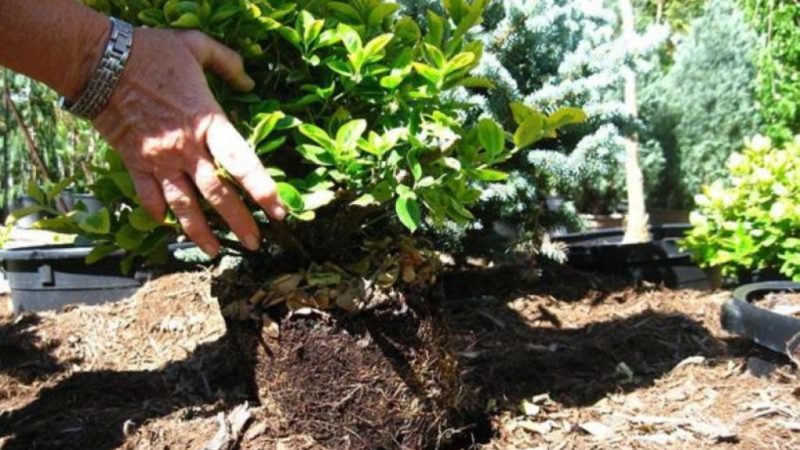
When is the best time to plant
Honeysuckle is planted in the ground in autumn, spring and summer. Experienced gardeners recommend doing this from late September to mid-October. In spring or summer, planting is carried out before bud break.
Important! From May to June, the culture is actively growing, so you cannot choose this period for planting.
The place on the site should be suitable for the bush. Primary requirements:
- good lighting and wind protection;
- high humidity;
- nutrient soil (loamy or sandy loam, sufficiently fertilized).
Before planting, the seedlings are carefully examined, the root system and branches are checked. The broken parts are removed, and all other roots are cut (leave 30 cm).
Sapling selection
If you only need berries, low-growing shrubs are suitable, to decorate the garden - tall ones, from which a hedge is obtained.
What to look for when buying seedlings:
- age: for planting in open ground, bushes at least 2 years old are suitable, but not older than 3;
- no damage (broken branches and roots are unacceptable);
- the presence of buds and developed roots.
It is better to buy seedlings of several varieties to increase the chances of successful pollination.
Reference! If the honeysuckle bark is peeling, it is not a sign of illness or marriage. For this feature, the plant was nicknamed "shameless".
How to plant correctly

Pre-check the acidity level soil... A suitable pH is 5.5–6.5.
How to properly plant honeysuckle:
- A few days before planting, make holes with a diameter of 0.4 m. Put a drainage layer in them.
- Fill up with fertile soil mixed with compost (about 1 bucket goes to one hole). It is advisable to add ash (200 g per well) and superphosphate (60 g).
- Pour water over the pits (for one - at least 2 buckets). If the hole sags, add soil until the hole is completely covered.
- In the center of the pits, form a small hill of earth, on the top of which place a seedling. Spread the roots and cover with earth.
- Water the seedlings. If the earth settles, sprinkle more. In this case, the root collar should be open.
- Around the bush, cover the ground with pine bark, old straw, dry grass.
It is better to take seedlings in containers: their roots are protected from damage. If the choice fell on ordinary shrubs with open roots, they are carefully examined for damage and rot.
At what distance
When choosing a place for honeysuckle in the garden, take into account which plants are (or will be) in the neighborhood. Edible honeysuckle - a culture, the roots of which secrete compounds into the soil that are detrimental to a number of other plants.
From each other
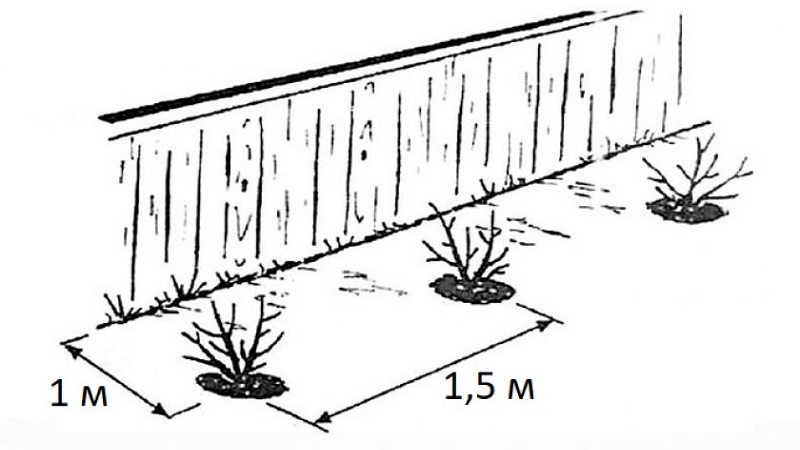
Honeysuckle will grow in one place for several decades, which means that they provide a free approach to each bush: branches of neighboring crops should not interfere with pruning, watering, fertilization.
The optimal distance between shrubs is 1 m.For spreading varieties, it is increased, for straight-growing ones, it is slightly reduced.Necessarily the neighborhood of two bushes (preferably several varieties), as plants with bisexual flowers (cross-pollinated). One shrub for an entire garden plot will not bear fruit.
From other plants
It is important to choose the right neighbors for honeysuckle. Plants in the garden area should develop harmoniously, not harm or interfere with other crops.
Suitable for planting next to edible honeysuckle:
- plum;
- barberry;
- black currant;
- annual crops (watermelon, cucumber, tomato, bell pepper);
- gooseberry;
- ground cover herbs (periwinkle, pachisandra);
- conifers (juniper, thuja).
Unsuitable neighbors:
- stone fruit crops (apricot, cherry);
- raspberries and blackberries;
- sea buckthorn;
- apple and pear;
- blueberry;
- Strawberry;
- fennel, hyssop, spurge.
The optimal distance is at least 2.5 m from the edible honeysuckle.
How to care for honeysuckle

Honeysuckle is an unpretentious shrub, does not need special care. The plant tolerates winter normally, but if there are severe frosts in the planting region, then it is insulated, for example, with coniferous spruce branches. In the spring, the insulation is removed and the soil is loosened.
Watering and feeding
Drying of the soil is unacceptable for honeysuckle; in the hot season, it requires regular watering. It is advisable to use warm water heated in the sun and moisturize the plants in the evening, after sunset. Water the crop as the soil dries up, the frequency depends on the climatic conditions.
Start top dressing in the second year: by then the planting nutrients have run out. Natural (organic) fertilizers work best for honeysuckle. A compost bucket is used for 1 bush. Fertilized once a year, in early spring. In the fall, add a layer of ash on top (1/3 of the bucket).
Pruning
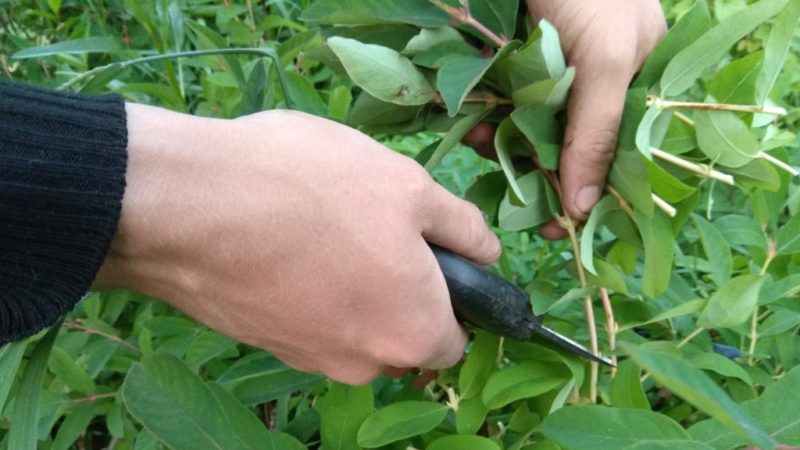
It is not recommended to prune the shrub during the first 3 years after planting. In subsequent years, the procedure is carried out in the fall, only if there are dried or diseased branches, the bush becomes too thick.
Advice! If the bush seems overly dense, remove several branches growing from the ground. Thin the crown - each branch should be illuminated by the sun's rays.
In the old plant, shoots and branches growing near the ground are cut off. Old branches are also removed: this will help the plant to rejuvenate.
Transfer
Honeysuckle tolerates transplanting well even in adulthood. It is recommended to carry out the procedure in the summer, after the harvest. The shrub is transplanted only when absolutely necessary (for example, if the place is not suitable for it, groundwater has come out close to the surface, etc.).
First of all, the bush is dug in and the edges of the root system are determined. They dig up the plant along with the earthen clod and transfer it to a new place, water it abundantly.
Reproduction of honeysuckle
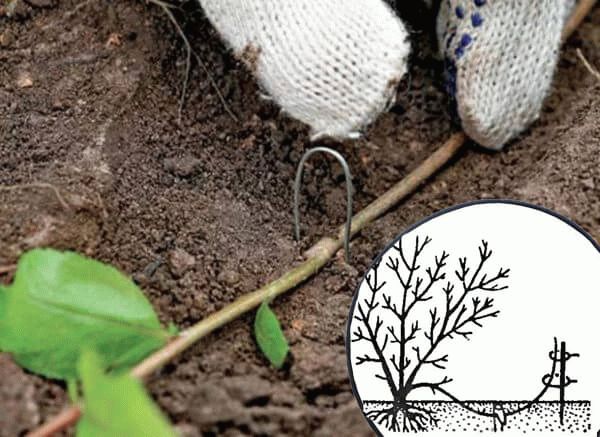
Several years after planting, the plant can reproduce independently:
All methods have their pros and cons. The choice depends on the time available and the ability to provide the new plant with proper care.
Seeds
Honeysuckle seeds sprout quickly and store well. For reproduction, you will need ripe or slightly overripe fruits. The pulp is smeared on white paper (office, toilet, paper towels are suitable), which is then dried in the sun. Seeds are collected, cleaned of pulp residues.
The best time of the year to plant honeysuckle is summer. The seeds are unpretentious, do not need preliminary germination. For the cultivation of shrubs, a mixture of black soil, sand and peat (in equal amounts) is used. The honeysuckle sown in the nutrient soil is placed under glass or in a greenhouse. The first shoots appear on the 20th day.
Interesting! The seeds are stored and do not lose their properties for up to 4 years.
For the winter, seedlings are taken out into the garden and left to winter under a layer of snow. When the future bushes grow up to 3 cm, they are planted in a garden bed, at a distance of 10-15 cm from each other.The shoots are regularly watered, loosened the soil, weed from weeds.
After a year, the plants are planted again, the distance between them is increased to 50 cm. After about 4 years, the first fruits appear and the honeysuckle is transplanted to a permanent place.
Cuttings
There are two types of cuttings - green and lignified. It's easier to use the latter.
To get new shrubs:
- Cuttings are cut 20 cm long, no more than 8 mm thick. The procedure begins in the spring.
- Workpieces are stuck into the soil at an angle.
- Cover the cuttings with a jar or thick transparent film.
- Moisten the soil regularly. The roots appear in a month.
- In the fall, the plants are planted.
Green cuttings are much more difficult to root. To get full-fledged seedlings, cuttings are kept in a greenhouse.
Layers
Honeysuckle propagation by layering is the easiest way. To get a new shrub, do the following:
- In early June, the soil around the bush is loosened.
- Choose several one-year-old stems and bend them to the soil, fix them (for example, with wire).
- Sprinkle with a layer of soil (3-5 cm).
- Provide regular watering.
- In the spring, the cuttings are separated from the bush and transplanted to a permanent place.
A full-fledged fruiting bush from the cut grows in about 2 years.
By dividing the bush
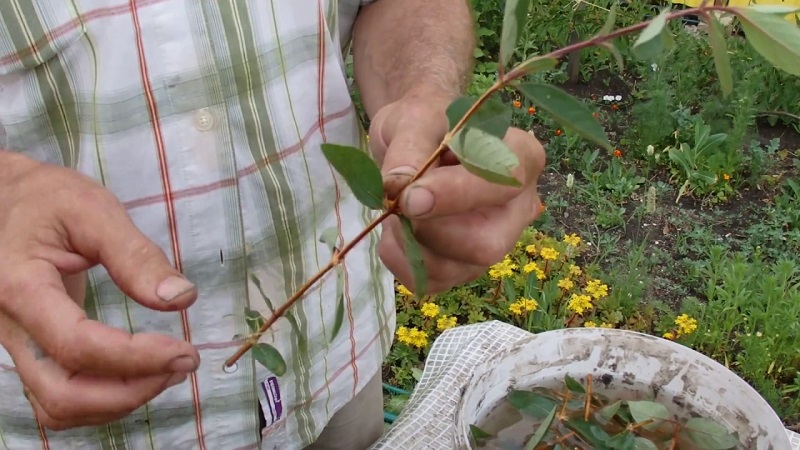
For division, only a plant at least 6 years old is suitable. In the spring, without waiting for the buds to swell, the bush is taken out of the ground, divided into several parts with a hacksaw or pruner. Places where the roots are cut are disinfected with coal. The resulting shrubs are planted in different places, watered abundantly, fertilized with compost (1 bucket per bush).
Too mature shrubs are not recommended to be divided: this will destroy the honeysuckle.
Conclusion
Honeysuckle does not cause much trouble to the owners of summer cottages. The bush will delight you with tasty and healthy fruits for many years, if you choose a suitable seedling, the optimal place for planting and follow the basic rules for caring for honeysuckle. The plant is resistant to frost, easily heals wounds and is practically not susceptible to disease. The shrub gets along with many fruit crops and is suitable for independent reproduction.